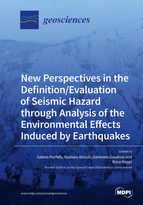New Perspectives in the Definition/Evaluation of Seismic Hazard through Analysis of the Environmental Effects Induced by Earthquakes
A special issue of Geosciences (ISSN 2076-3263). This special issue belongs to the section "Natural Hazards".
Deadline for manuscript submissions: closed (31 July 2019) | Viewed by 101612
Special Issue Editors
Interests: natural hazards; active tectonics; historical and recent seismicity; seismic risk; seismic hazard; environment; paleoseismology; floods; historical floods; disasters induced by earthquakes; cultural heritage; resilience
Special Issues, Collections and Topics in MDPI journals
Interests: seismotectonics; earthquake geology; natural hazard; geoheritage
Special Issues, Collections and Topics in MDPI journals
Interests: tectonics; structural geology; geology; exploration geophysics; plate tectonics; seismics; quaternary geology; geodynamics; geophysics; applied geophysics; seismology; earthquake
Special Issues, Collections and Topics in MDPI journals
Interests: seismotectonics; earthquake geology and paleoseismology; seismic hazard; tectonic geomorphology; active tectonics; historical and recent seismicity; geological mapping; volcanic geomorphology
Special Issues, Collections and Topics in MDPI journals
Special Issue Information
Dear Colleagues,
The devastating effects caused by the recent catastrophic earthquakes that took place all over the world—from Japan, New Zealand, to Chile, as well as those occurring in the Mediterranean basin—have once again shown that the ground motion, although a serious source of direct damage, is not the only parameter to be considered, most damage being due to coseismic geological effects that are directly connected to the earthquake source or caused by ground shaking. Primary effects such as surface faulting, regional uplift, and subsidence, and secondary effects such as tsunami, liquefaction, ground failure, and landslides (sensu ESI 2007 scale) must be considered for a more correct and complete evaluation of seismic hazard, both at regional and local scales.
This Special Issue aims to collect all contributions that using different methodologies can integrate new data produced with multi-disciplinary and innovative methods. These methodologies are essential for the identification and characterization of seismically active areas, and for the development of new hazard models, obtained using different survey techniques. The contributions related to seismic-induced effects in volcanic areas (currently not well-examined) will also be particularly appreciated, since in such areas even high-energy earthquakes can induce both surface faulting and secondary effects, as recently observed for the volcano-tectonic earthquake of Md = 4 that occurred on August 21, 2017 in the Island of Ischia (Campania, Southern Italy).
Dr. Sabina Porfido
Dr. Giuliana Alessio
Dr. Germana Gaudiosi
Dr. Rosa Nappi
Guest Editors
Manuscript Submission Information
Manuscripts should be submitted online at www.mdpi.com by registering and logging in to this website. Once you are registered, click here to go to the submission form. Manuscripts can be submitted until the deadline. All submissions that pass pre-check are peer-reviewed. Accepted papers will be published continuously in the journal (as soon as accepted) and will be listed together on the special issue website. Research articles, review articles as well as short communications are invited. For planned papers, a title and short abstract (about 100 words) can be sent to the Editorial Office for announcement on this website.
Submitted manuscripts should not have been published previously, nor be under consideration for publication elsewhere (except conference proceedings papers). All manuscripts are thoroughly refereed through a single-blind peer-review process. A guide for authors and other relevant information for submission of manuscripts is available on the Instructions for Authors page. Geosciences is an international peer-reviewed open access monthly journal published by MDPI.
Please visit the Instructions for Authors page before submitting a manuscript. The Article Processing Charge (APC) for publication in this open access journal is 1800 CHF (Swiss Francs). Submitted papers should be well formatted and use good English. Authors may use MDPI's English editing service prior to publication or during author revisions.
Keywords
- seismic hazard assessment
- ESI 2007 scale
- environmental effects triggered by earthquakes
- primary and secondary effects
- active tectonic
- historical and recent earthquakes
- paleoseismology
- volcano-tectonic earthquakes
- new hazard model
- ground effects: resilience and cultural heritage
Related Special Issues
- Site-Specific Seismic Hazard Analysis: New Perspectives, Open Issues and Challenges in Geosciences (14 articles)
- Large Subduction Earthquakes and Tsunamigenesis in Geosciences
- Advances in tsunami science towards tsunami threat reduction in Geosciences (3 articles)
- Interdisciplinary Geosciences Perspectives of Tsunami Volume 2 in Geosciences (13 articles)
- Remote Sensing Application for Earthquake and Tsunami Damage Assessment in Geosciences (3 articles)
- Interdisciplinary Geosciences Perspectives of Tsunami in Geosciences (11 articles)








